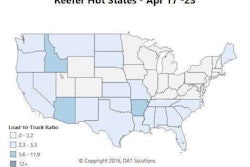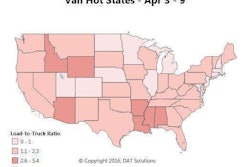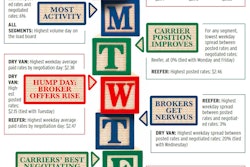Following last week’s report suggesting a warming trend, it’s clear at least that, as regards rates, nationally and across trailer types we’re still on the downswing. National average rates dropped again.
At once, all equipment types could be getting ready for a rebound. Why? Load availability, judged by activity in the network of DAT load boards, was up in the largest van freight markets last week, accompanied by a whopping 30 percent increase in reefer freight movements compared to the previous week. Flatbed is also gaining strength, especially in the Southeast and South Central regions.
 The market for flatbed freight has been bucking the wider downward rate trend itself this month — up 5¢ per mile for flatbeds so far in April over March. That’s thanks to big increases on the highest-volume lanes. Freight is gaining strength and rates are holding up well in the Southeast, including lanes originating in Atlanta, Roanoke, Va., and Savannah, Ga. Memphis outbound rates improved by 14 cents per mile this month to an outbound average of $2.46. The lane from Memphis to Dallas added 8 cents last week, and it’s up 22 cents for the month, to $2.29 per mile. This is a good way into Texas, where you can usually find a load out of Dallas, Fort Worth and especially Houston. One Southeast regional lane to avoid: Raleigh to Baltimore. That rate is back down to $2.31/mile after a two-week surge, and you don’t want to be stuck looking for a load out of Baltimore anyway.
The market for flatbed freight has been bucking the wider downward rate trend itself this month — up 5¢ per mile for flatbeds so far in April over March. That’s thanks to big increases on the highest-volume lanes. Freight is gaining strength and rates are holding up well in the Southeast, including lanes originating in Atlanta, Roanoke, Va., and Savannah, Ga. Memphis outbound rates improved by 14 cents per mile this month to an outbound average of $2.46. The lane from Memphis to Dallas added 8 cents last week, and it’s up 22 cents for the month, to $2.29 per mile. This is a good way into Texas, where you can usually find a load out of Dallas, Fort Worth and especially Houston. One Southeast regional lane to avoid: Raleigh to Baltimore. That rate is back down to $2.31/mile after a two-week surge, and you don’t want to be stuck looking for a load out of Baltimore anyway. Reefer freight volume was way up last week in most major markets. Hot spots last week included Nogales, Ariz., on the Mexican border, as well as produce markets in California and Southern Georgia. There was even a surge in freight out of Florida last Friday. The average rate for reefer loads was $2.02/mile from Nogales to Dallas, which was up 13 cents compared to the previous week. Nogales, near Tucson, has been the top market for reefer load availability in the past two weeks, with 10.6 loads per truck. Another Mexican border crossing in McAllen, Texas, offered loads to Dallas for $2.42 per mile, up 27 cents last week. Atlanta continues to improve, and the lane to Dallas climbed 15 cents to $1.78/mile last week.
Reefer freight volume was way up last week in most major markets. Hot spots last week included Nogales, Ariz., on the Mexican border, as well as produce markets in California and Southern Georgia. There was even a surge in freight out of Florida last Friday. The average rate for reefer loads was $2.02/mile from Nogales to Dallas, which was up 13 cents compared to the previous week. Nogales, near Tucson, has been the top market for reefer load availability in the past two weeks, with 10.6 loads per truck. Another Mexican border crossing in McAllen, Texas, offered loads to Dallas for $2.42 per mile, up 27 cents last week. Atlanta continues to improve, and the lane to Dallas climbed 15 cents to $1.78/mile last week. Van rates continued to fall, but load availability increased in the six biggest van markets, with a lot more outbound freight leaving Atlanta and Stockton, Calif., in particular. Improved rates usually follow increased demand. Unfortunately, not much to say for Northeast rates. The West Coast is gaining traction: Imports are up, and those loads tend to arrive there, then move inland to the Northeast, so you get a lot of extra trucks competing for Westbound loads. The lane from Denver to Stockton, Calif., plunged 20 cents to an almost unbelievable $0.87/mile. Stockton has good volume right now, but this isn’t the best way to get there, even if you’re stuck in Denver.
Van rates continued to fall, but load availability increased in the six biggest van markets, with a lot more outbound freight leaving Atlanta and Stockton, Calif., in particular. Improved rates usually follow increased demand. Unfortunately, not much to say for Northeast rates. The West Coast is gaining traction: Imports are up, and those loads tend to arrive there, then move inland to the Northeast, so you get a lot of extra trucks competing for Westbound loads. The lane from Denver to Stockton, Calif., plunged 20 cents to an almost unbelievable $0.87/mile. Stockton has good volume right now, but this isn’t the best way to get there, even if you’re stuck in Denver.Go to L.A. instead. That rate is only slightly better, at $1.04/mile based on averages extracted from DAT RateView. The average rate from L.A. back to Stockton, however, is averaging $2.22/mile. That 338-mile leg adds almost $650 in total revenue to the round for a roundtrip rate of $1.55/mile for all loaded miles — that beats this week’s van national average. Examine the details — all rates averages on those lanes — below.











